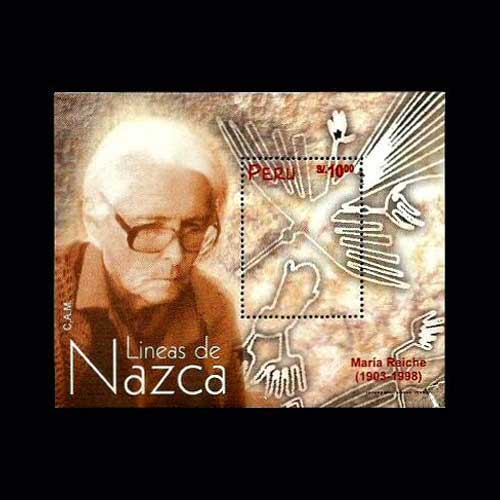Maria Reiche: The lady of Nazca Lines
2018-02-28 Wed
The geometric lines that you see on the featured stamp are one of the most mysterious lines in the world. They are popularly known as geoglyph, located in the Nazca desert (Peru). It is believed by the scholars that these deep lines were created in c.500 BCE to 500 CE. There are several hundreds of the figures on the ground. They were first discovered in 1927 by the archaeologist Toribio Mejía Xesspe.However, what was the purpose behind creating these lines?
Archaeologist, Ethnologist, and Anthropologist are trying hard to know the reason behind it. The following reasons are assumed to be behind the creation of the Nazca lines.
The first theory says it was created by the Nazca people so that God can see them from the sky. The figures are symbols representing animals and objects meant to invoke the gods' aid in supplying water.
Another theory says it was a purpose related to astronomy and cosmology: the lines were intended to act as a kind of observatory, to point to the places on the distant horizon where the sun and other celestial bodies rose or set in the solstices. Some or all of the figures represented constellations.
There are 300 figures which include spider, lizard, tree, hummingbird, spiral, whale, monkey, fish, hand, flower, and, etc.
Maria Reiche, a German mathematics, and archaeologist studied the Nazca lines for 40 years and fought unyieldingly for her theories on the lines’ astronomical and calendar purpose. She also received a National Geographic grant in 1974 for her work.
Reiche battled single-handedly to protect the site and she even lived in a small house near the desert so she could personally protect the lines from reckless visitors. To commemorate Maria Reiche, Peru issued a miniature sheet depicting the mysterious Nazca lines with Maria Reiche. However, the research is still going on the Nazca lines and the massiveness and purpose of these lines is still a matter of mystery and debate.
Latest News
-
Gold Pagoda of Vijaynagar Empire King Deva Raya I
2024-04-10 WedKing Deva Raya I of the Vijayanagara Empire was a patron of Kannada literature and architecture. He ...
-
Silver Denarius of Septimus Severus
2024-04-05 FriLucius Septimius Severus served as the Roman emperor from 193 to 211 AD. Severus sat on the throne o...
-
Extremely rare 'Malaharamari' type Gold Gadyana of King Guhalladeva-III Sold for INR 611000
2024-04-03 WedTribhuvanamalla, also known as Guhalladeva III, was the ruler of the Kadamba dynasty. His reign coin...
-
90 Years of RBI
2024-04-02 TueOn 1st April, PM #Modi unveiled a special commemorative coin marking 90 Years since the foundation o...
-
Silver Denarius of Julia Mamaea
2024-04-02 TueJulia Avita Mamaea, a Christian Syrian noblewoman, was the mother of Roman Emperor Alexander Severus...

